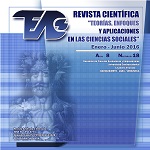The New forms of organization and socially responsible business, fundamental for the development of innovation parts
Keywords:
new forms of organization, socially responsible business, innovation, competitivenessAbstract
Through collaborative work promoting new forms of business organization in an exchange of good wishes to build better organizations better citizens and workers who promote human sense and good practice is generated. To build strong, well-integrated and strengthened organizations use, application and development of the concept of Socially Responsible Company is required, which involves supporting society to protect the environment, generate among employees harmony and quality life through decent wages and environments of collaboration and mutual support for compliance activities. Production processes and results generated from the adoption of new forms of organization in the development of the nested philosophy on the concept of Socially Responsible Company, foster a favorable environment for the generation of new ideas crystallizing innovation. The aim of this paper is to analyze how the new forms of organization presenting the SMEs in the state of Sinaloa, located in Mexico, are helping to get the Socially Responsible Company, and this generates a greater ability to develop innovation processes . The methodology is a documentary research under an analytical approach to help identify the adoption of new forms of organization by the sinaloenses SMEs facilitates the adoption of distinctive Socially Responsible Company. In the results obtained only 20% of SMEs in Sinaloa adopts the distinctive Socially Responsible Company and 70% of them follows a traditionalist model, adopting mechanistic processes that by their nature are very innovative.
Downloads
References
Barnett, Michael (2007). Stakeholder Influence Capacity and the Variability of Financial Returns to Corporate Social Responsibility. Academy of Management Review, 794-816.
Carrasco, Inmaculada (2007). Corporate Social Responsibility, values and cooperation. International Advances in Economic Research, 454-460.
Centro Mexicano para la Filantropía . Informe Anual 2015. Página web en línea. Fuente: www.cemefi.org/informes/informe2016 (consultado el 20-02-2016).
Flores Kelly, Jorge (2013). México Necesita menos PYMES. Revista Electrónica México FORBES. 20 de marzo del 2013. www.forbes.com.mx/Mexico-necesita-menos-pymes.
Godos, José Luis, & Gago, Roberto Fernández (25 de septiembre de 2010). Como se Percibe la Dirección Socialmente Responsable por parte de los Altos Directivos de Empresas en España. Obtenido de Universia Business Review: www.redalyc.org/artículo.oa?id=43317992002
Heyderbrand, Wolf (1989). New Organizational Forms. In Work & Occupations, 25.
Instituto Nacional de Estadística y Geografía. 2012 . Página web en Línea. Fuente: http://www3.inegi.org.mx/sistemas/mapa/denue/default.aspx (Consultado el 20- 02-2016).
Kanter, Moss Rosabeth (1999). “When a thousand flowers bloom: structural, collective and social”. Greenwich: Jai Press.
Lee, Ming-Don Paul (2008). A Review of the Theories of Corporate Social Responsibility: Its evolutionary Path and the road ahead. International Journal of Management Review, 53-73.
Maignan, Isabelle (2001). Consumers Perceptions of Corporate Social Responsibilities: A cross-cultural comparison. Journal of Business Ethics, 57-72.
McWilliams, Abagail & Siegel, Donald (2001). Corporate Social Responsability: A theory of the firm Perspective. Academy of Management Review, 117-127.
Méndez, Ricardo (2002). Innovación y Desarrollo Territorial. Eure (Santiago).
Mozas Moral, Adoración, & Puentes Poyatos, Raquel (2010). La Responsabilidad Social Corporativa y su Paralelismo con las Sociedades Cooperativas. REVESCO, 75-100.
Pedersen, Esben Rahbek & Peter Neergaard (2009). What Matters to Managers? The Whats, whys and hows of Corporate Social Responsibility in a Multinational Corporation. Management Decision, 1261-1280.
Porter, Michael & Kramer, Kramer (2002). The Competitive Advantage of Corporate Philantrophy. Harvard Business Review, 56-68.
Rivas Tovar, Luis Arturo (2002). Nuevas Formas de Organización. Estudios Gerenciales.
Rodríguez Peñuelas, Marco Antonio (2003). El Proceso de Modernización de la Empresa Hortícola Sinaloense: El caso de la Empresa Agrícola San Isidro. Culiacán, Sinaloa, México. Universidad Autónoma de Sinaloa.
Rodríguez Peñuelas, Marco Antonio (2010). El Cambio Organizacional en las Pymes
Sinaloenses. Una Respuesta a los Desafíos del Entorno. Culiacán Sinaloa, México. Universidad Autónoma de Sinaloa.
Sojo, Eduardo (2015, Febrero 18). Situación Actual de las PYMES respect a su Sobrevivencia y Crecimiento. (Entrevista publicada por el periódico el |Economista).
World Business Council for Sustainable Development(WBCSD), W. B. (2002).
Corporate Social Responsibility. The WBCSD's Journey.
Vega, Luis (2012). Formas de Organización de las Actividades de Producción y Comercialización de las Empresas Hortícolas Sinaloenses. Situación Actual y Perspectivas. México D.F.: Ediciones del Lirio en coedición con la Universidad de Occidente.
Vega, Luis, López Barraza, Lydia María, & Martínez Huerta, Ramón (2014). Las Nuevas Formas de Organización y su Relación en la Generación de Innovación consolidando la Ventaja Competitiva de la Empresa Hortícola Sinaloense. Retos Actuales del Cambio y de las Intervenciones en las Organizaciones (pág. 17). Lyon Francia: ISEOR 2014.
Published
How to Cite
Issue
Section
Derechos del/de autor/es a partir del año de publicación
Esta obra está bajo la licencia:
Creative Commons Reconocimiento-NoComercial-CompartirIgual 4.0 Internacional (CC BY-NC-SA 4.0)
Las opiniones expresadas por los autores no necesariamente reflejan la postura del editor de la publicación ni de la UCLA. Se autoriza la reproducción total o parcial de los textos aquí publicados, siempre y cuando se cite la fuente completa y la dirección electrónica de esta revista. Los autores(as) tienen el derecho de utilizar sus artículos para cualquier propósito siempre y cuando se realice sin fines de lucro. Los autores(as) pueden publicar en internet o cualquier otro medio la versión final aprobada de su trabajo, luego que esta ha sido publicada en esta revista.



